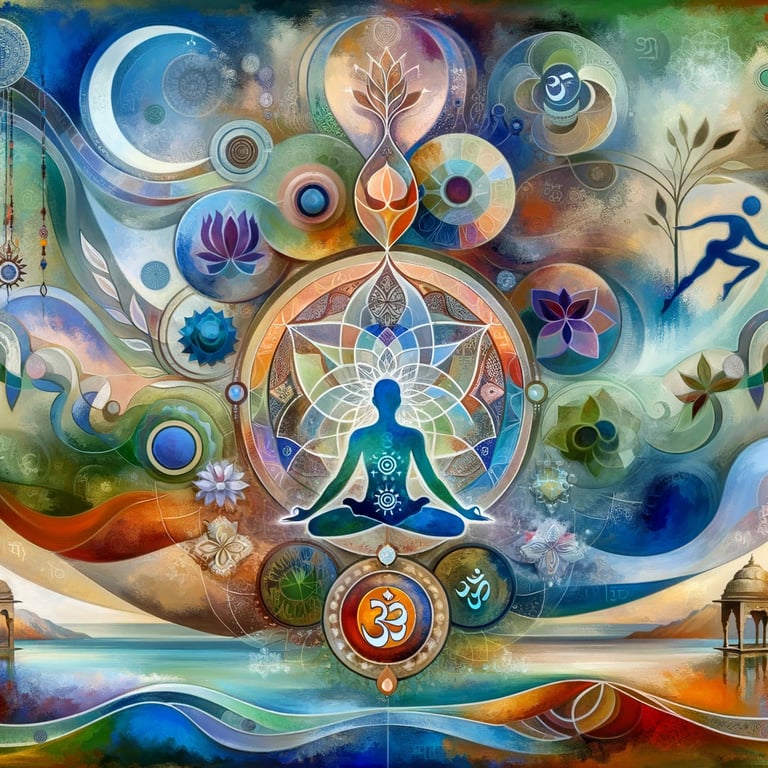




Yoga
Yoga Nidra
Dhyana Yoga
Laya Yoga
Yoga
Yoga encompasses a wide range of physical, mental, and spiritual exercises and disciplines that have their origins in India.
It aims to unite the body, mind, and spirit to achieve a state of enlightenment or self-realization. The practice of yoga has been around for more than five thousand years, with its roots deeply embedded in the religious, spiritual, and cultural life of the Indian subcontinent.
Historical Background
Yoga's history can be divided into several periods, including the Vedic Yoga period, the Pre-Classical Yoga period, the Classical Yoga period, and the Post-Classical Yoga period. The earliest references to yoga are found in the Vedas, ancient texts among the oldest sacred scriptures of Hinduism. Yoga was later systematized in the Yoga Sutras of Patanjali, considered one of the foundational texts of classical yoga philosophy.
Major Branches of Yoga
Hatha Yoga: Focuses on physical postures (asanas), breath control (pranayama), and meditation. It is designed to align and calm the body, mind, and spirit in preparation for meditation.
Raja Yoga: The "royal path" focuses on meditation and closely follows a structured series of disciplinary steps referred to as the "eight limbs" of yoga.
Bhakti Yoga: The path of devotion, seeing the divine in all creation, and lovingly serving the divine in all beings.
Karma Yoga: The yoga of action said that service rendered without attachment to outcomes purifies one's mind and gradually leads to liberation.
Jnana Yoga: The path of wisdom emphasizes applying discriminative intelligence to achieve spiritual liberation.
Tantra Yoga: Involves a variety of rituals, including meditation, breath control, chanting, and sacred sexuality, to awaken kundalini energy and achieve spiritual liberation.
Benefits of Yoga
Yoga offers benefits for both the body and mind. Physically, it can improve flexibility, strength, balance, and endurance. Mentally, it can alleviate stress, anxiety, and depression.
We are enhancing overall well-being and quality of life. Regular practice can also improve concentration, energy levels, and sleep quality.
Modern Practice
Today, yoga is practised worldwide in various forms, from traditional methods to modern adaptations like power and Bikram yoga. It has grown in popularity as a form of physical exercise based on poses promoting improved control of the mind and body and enhancing well-being.
Whether one engages in yoga for physical fitness, mental clarity, spiritual growth, or a combination, it offers a rich and diverse practice with something for everyone. Classes can be found in local yoga studios, community centres, and even online platforms, making them accessible to a broad audience.
Dhyana Yoga, often referred to simply as Dhyana, is a form of meditation and a critical practice within the broader yoga system. The term "Dhyana" is derived from Sanskrit and can be translated as "meditation," signifying a profound state of contemplation or meditation. In the Yoga Sutras of Patanjali, it is considered one of the eight limbs of Ashtanga Yoga, a foundational text of classical yoga philosophy.
Understanding Dhyana in the Context of Ashtanga Yoga
Ashtanga Yoga, or the Limbs of Yoga, is a system that guides practitioners through a series of practices designed to purify the body and mind, leading to spiritual enlightenment. The eight limbs are:
Yama (ethical standards or moral codes)
Niyama (self-discipline and spiritual observances)
Asana (posture practice for physical health and stability)
Pranayama (breath control)
Pratyahara focuses on (the withdrawal of the senses from external objects)
Dharana (Focus on a single point)
Dhyana (meditation or contemplation, the uninterrupted flow of attention)
Samadhi (superconscious state or union with the divine)
The Practice and Significance of Dhyana
Dhyana involves a deep meditation where the practitioner achieves an uninterrupted flow of concentration. This stage comes naturally after Dharana, where the individual learns to focus on a single point or idea. In Dhyana, this focused concentration is extended and deepened, leading to meditative absorption, where the sense of self begins to dissolve. The practitioner becomes fully immersed in the object of attention, and a state of unity between the realization occurs between the meditator (subject) and the focus of meditation (thing).
Benefits of Dhyana
Practising Dhyana has several benefits, including:
Mental Clarity and Peace: Regular meditation helps clear the mind of unnecessary clutter, leading to greater peace, clarity, and focus.
Reduced Stress and Anxiety: Dhyana can significantly reduce stress, depression and anxiety levels by calming the mind and body.
Enhanced Self-Awareness: Through meditation, practitioners can gain deeper insights into their thoughts, emotions, and behaviours, leading to greater self-awareness and self-understanding.
Spiritual Growth: Dhyana is a path toward spiritual enlightenment, offering practitioners a deeper connection with their inner self and the universe.
Incorporating Dhyana into Your Practice
Incorporating Dhyana into your practice, starting with the preceding limbs, particularly Dharana, is beneficial to develop the ability to concentrate on a single focus point. Once you can maintain concentration without effort, you can transition into Dhyana, allowing your meditation to deepen naturally.
Dhyana is not about forcing the mind to be quiet; instead, it's about discovering the silence already present when we can let go of external distractions and internal chatter. This profound state of meditation is accessible to anyone willing to dedicate time and practice towards achieving it.
Yoga Nidra
Yoga Nidra, often called "yogic sleep," is a powerful meditation technique and one of the deepest forms of relaxation while maintaining full consciousness. It involves a systematic method of inducing complete physical, mental, and emotional peace. Unlike traditional sleep, where you lose consciousness, Yoga Nidra puts you between wakefulness and sleep, allowing you to explore your inner world.
Historical and Philosophical Background
Yoga Nidra has its roots in tantric practices, but it was Swami Satyananda Saraswati, founder of the Bihar School of Yoga in India, who, in the mid-20th century, developed and popularized the form of Yoga Nidra practised by many in the West today. It is based on traditional yogic teachings and modern psychological and scientific approaches to body and mind.
The Practice of Yoga Nidra
The practice typically occurs in a lying position (Savasana), where the practitioner's only job is to follow the instructor's voice. The instructor guides the session, which includes several stages:
Preparation: This stage involves physical and mental relaxation, usually through deep breathing or guided imagery techniques.
Sankalpa: A resolve or intention set by the practitioner, a simple short sentence focusing on a personal goal or desire for well-being.
Rotation of Consciousness: The instructor guides the practitioner's awareness of different body parts in a specific sequence, promoting physical relaxation and sensory awareness.
Breath Awareness: Focusing on the breath to deepen relaxation and awareness.
Visualization: This stage involves guided imagery to deepen the meditative state further, allowing the practitioner to explore more profound levels of consciousness.
Sankalpa Revisited: The intention set at the beginning is mentally repeated, reinforcing its significance.
Closing: Gradually, the practitioner is guided back to a state of wakefulness, ending the session.
Benefits of Yoga Nidra
Yoga Nidra offers numerous benefits for physical, mental, and emotional health, including:
Stress Reduction: It is highly effective in reducing stress and anxiety.
Improved Sleep: Regular practice can enhance sleep quality and help combat insomnia.
Enhanced Concentration: It can increase focus and attention span.
Emotional Healing: Yoga Nidra can be a valuable tool in processing and healing emotional trauma.
Physical Relaxation: Helps relieve physical tension and restore energy levels.
Access to the Subconscious: By reaching deep relaxation, you can tap into the subconscious mind, which can benefit personal growth, creativity, and problem-solving.
How to Practice
While Yoga Nidra can be practised independently using guided recordings, many find it beneficial to begin with an instructor who can provide personalized guidance. Sessions can be between 20 to 60 minutes. It requires no special equipment or environment, though a quiet, comfortable space where you won't be disturbed is ideal.
Yoga Nidra is a versatile practice that suits individuals of all ages and physical conditions. It's a profound technique that enriches the practitioner's inner life, offering a gateway to more profound relaxation, health, and well-being.
Laya Yoga
Laya Yoga, often associated with the term "Laya", meaning dissolution or absorption, is a spiritual path within the broader spectrum of yoga practices. It focuses on the dissolution of the individual self into the universal consciousness. Laya Yoga is deeply connected with Kundalini Yoga and Tantra Yoga, as it involves the awakening and rising of the Kundalini energy—the primal energy located at the base of the spine.
Historical and Philosophical Foundations
The origins of Laya Yoga are tied to ancient Hindu and tantric philosophies, where it is described as a method for expanding consciousness and merging with the divine. Although specific historical origins are less documented than other forms of yoga, its practices are detailed in various tantric texts and later yoga Upanishads.
Critical Practices of Laya Yoga
Laya Yoga includes a series of advanced spiritual and physical practices to raise and harmonize the Kundalini energy. The main components include:
Mantra: The use of specific sounds or vibrations to concentrate the mind and induce a meditative state. Mantras in Laya Yoga are often used to awaken the Kundalini energy.
Tantra: Techniques that involve rituals, meditation, and symbols to explore the energies of the body and the universe.
Pranayama: Breathing exercises designed to control and direct the Prana (life energy) to awaken the Kundalini energy.
Mudras and Bandhas: Specific body gestures and locks used to guide energy flow and aid in the awakening of Kundalini.
Meditation: Deep meditation practices focus on the ego's dissolution and the realization of oneness with the universe.
Goals of Laya Yoga
The ultimate goal of Laya Yoga is the state of Samadhi, where individual consciousness dissolves into universal consciousness, leading to spiritual liberation (Moksha). This path emphasizes the transcendence of the physical and mental realms, achieving a state of pure bliss and knowledge.
Kundalini Awakening in Laya Yoga
A central aspect of Laya Yoga is the awakening of the Kundalini Shakti, a latent potential force within every individual. This process involves guiding the Kundalini energy from the base of the spine and through the seven chakras (energy centres) to reach the Sahasrara (crown chakra) at the top of the head. Through this awakening, one is believed to achieve enlightenment and understanding of the universe.
Practice and Guidance
Due to the complex and robust nature of the practices involved in Laya Yoga, it is strongly recommended to pursue this path under the guidance of an experienced teacher. The awakening of Kundalini energy, in particular, can be intense and transformative, requiring careful preparation, advice, and support.
Laya Yoga offers a deep, introspective, and spiritually enriching path for those drawn to explore the innermost depths of consciousness. One can reach the pinnacle of spiritual development through its practices, experiencing the ultimate unity with the cosmos.


Yoga


